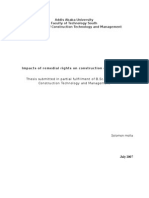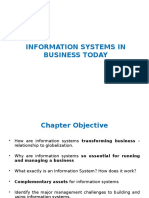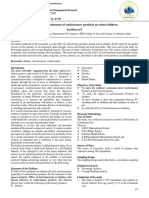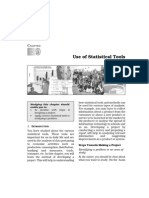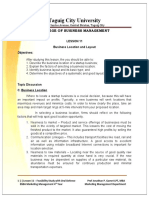Statistical Analyses For Simulating Schedule Networks
Statistical Analyses For Simulating Schedule Networks
Uploaded by
Francois-Copyright:
Available Formats
Statistical Analyses For Simulating Schedule Networks
Statistical Analyses For Simulating Schedule Networks
Uploaded by
Francois-Original Description:
Original Title
Copyright
Available Formats
Share this document
Did you find this document useful?
Is this content inappropriate?
Copyright:
Available Formats
Statistical Analyses For Simulating Schedule Networks
Statistical Analyses For Simulating Schedule Networks
Uploaded by
Francois-Copyright:
Available Formats
Proceedings of the 2004 Winter Simulation Conference
R .G. Ingalls, M. D. Rossetti, J. S. Smith, and B. A. Peters, eds.
ABSTRACT
This paper introduces the Stochastic Project Scheduling
Simulation (SPSS) system and two additional useful statisti-
cal analysis tools. SPSS integrates CPM, PERT, and Dis-
crete Event Simulation (DES) scheduling methods into one
system. It can generate a CPM-based deterministic schedule,
a PERT-based probabilistic schedule, and a simulation-
based stochastic schedule for the project under study. Two
additional statistical analysis tools are added to assist users
in determining the number of simulation runs needed for a
given schedule network and testing the significance of dif-
ference between two independent simulation experiments.
1 INTRODUCTION
Due to the limitations of CPM and PERT scheduling meth-
ods, simulation has been applied to schedule networks by
considering random activity durations for estimating project
durations (Douglas 1978, Ahuja and Nandakumar 1985).
Moreover, simulation has been widely employed as a useful
tool for planning construction processes or operations (Mar-
tinez and Ioannou 1997, 1999, Ahuja 1984, Ioannou 1989,
Shi 1999, Hajjar and AbouRizk 1999).
A construction project may be consisted of hundreds
or thousands of activities. When simulation is applied to
schedule a project, the first question must be answered is
how many simulation runs must be conducted. Number of
simulation runs needed is project-specific. It is jointly af-
fected by many factors such as number of activities in the
project, relationships between activities, formulation of the
critical path(s), and distributions of activity durations.
A simulation cannot be executed indefinitely. Generally
speaking, a large number of simulation runs leads to a statis-
tically valid simulation results but it will consume a long
computing time. Although new computing technology has
made computing time not a major concern for small to me-
dium projects, computing time may be still crucial for large
projects, e.g., with thousands of activities. Reducing un-
needed simulation runs will improve the efficiency of a simu-
lation process. The validity of simulation results depends
upon the number of simulation runs. If it is terminated pre-
maturely, the obtained results may not objectively represent
the process under study and therefore be invalid. Properly de-
termining the number of runs needed for a given project
helps determine the minimal computing time and ensure
valid results. Moreover, when multiple simulation experi-
ments are conducted for the same schedule network, different
results may be obtained due to different streams of random
numbers. It is essential to examine the difference between
the results of the different experiments. They should be statis-
tically identical in order to valid the experiments.
This article discusses two important statistical factors
for schedule simulation: (1) determining number of simula-
tion runs for a given schedule network, and (2) testing the
significance of the difference between any two simulation
experiments. JAVA components are developed in the SPSS
system for carrying out the two functions.
2 THE STOCHASTIC PROJECT SCHEDULE
SIMULATION (SPSS) SYSTEM
The SPSS system provides a computer tool for analyzing a
schedule network by using CPM, PERT, and DES methods
(Lee 2004). CPM uses a deterministic approach, PERT
uses a probabilistic approach, and DES uses a discrete
event simulation approach for scheduling construction pro-
jects. Although PERT shows an advantage over CPM by
providing a probabilistic approach for representing activity
durations, a PERT schedule has found to be conservative
because the method systematically underestimates the
probability to complete a project in a given time (Halpin
and Riggs 1992, Shi 2001). The DES approach would im-
prove the accuracy of a PERT schedule. SPSS allows a
user to select any preferred methods freely and to compare
the schedules from the three methods for a given project.
SPSS can assist a user in estimating the probability of
completing a project within a given time. SPSS collects all
STATISTICAL ANALYSES FOR SIMULATING SCHEDULE NETWORKS
Dong-Eun Lee
Jonathan Jingsheng Shi
Construction Engineering and Management Program
Department of Civil and Architectural Engineering
Illinois Institute of Technology
3201S. Dearborn St.,
Chicago, IL 60616-3793, U.S.A.
1283
Lee and Shi
of the results from the conducted simulation runs and con-
duct statistical analyses accordingly.
3 THE METHODOLOGY
Calculating the probability of completing a project in a
given time using simulation technique involves: (1) deter-
mining the activity durations, (2) conducting a simulation
experiment for the network and determining the critical
path in the network, (3) computing project duration with
the longest path, and (4) conducting multiple simulation
runs by repeating steps 1 to 3, and (5) computing mean
project duration, standard deviation, and probability to
complete the project in a desired time.
SPSS was implemented with the three scheduling
methods (CPM, PERT, and DES) as shown in Figures 1, 2,
3, respectively (Lee 2004). The same activity diagram is
shared by the three methods in SPSS as shown in Figure 4.
If the DES scheduling method is selected, the user
may enter a desired number of simulation runs as shown in
Figure 3. However, the program will calculate the mini-
mum number of simulation runs needed based on the given
confidence level. If the number of simulation runs is given
by the user, the system will return a confidence interval for
the mean project duration under a given confidence.
Three point estimates (optimistic, most-likely, and
pessimistic times) are used in PERT. For comparison pur-
pose, the same three point estimates are used for the ac-
tivities of the schedule network under simulation study.
Triangular distributions are used modeling for activity du-
rations ( in Figure 4).
A simulation experiment will be conducted for 120 runs
with simulation results to be collected from each run. Then,
the mean project duration and its confidence interval are cal-
culated for the samples in the experiment. Estimating the
confidence interval requires the mean () and standard de-
viation () of the population. Since the population standard
deviation is unknown, an unbiased estimate of the standard
deviation (S
x
) is used as the standard deviation of the popu-
lation (Mohammadi 2002). If a desired project duration is
given, SPSS can also calculate the probability for the project
to be completed in the given time as shown in Figure 3.
3.1 Determining the Number of Simulation Runs
The methodology for computing the minimal number of
simulation runs is based on the error term resulted from the
sample. SPSS first calculates the unbiased estimates of
mean and the standard deviation values. Then the confi-
dence interval of the mean is computed in the range be-
tween the lower bound exact mean (LBEM) and upper
bound exact mean (UBEM) (Ang and Tang 1975, Khisty
and Mohammadi 2001, Mohammadi 2002).
Figure 1: Deterministic CPM in SPSS
1284
Lee and Shi
Figure 2: Probabilistic PERT in SPSS
Figure 3: Stochastic Discrete Event Simulation in SPSS
1285
Lee and Shi
Triangular(o1,e1,p1) PERT(o1,e1,p1)
PERT(o2,e2,p2)
PERT(o3,e3,p3)
PERT(o4,e4,p4)
PERT(o5,e5,p5)
PERT(o6,e6,p6)
PERT(o7,e7,p7)
CPM(e1)
CPM(e2)
CPM(e3)
CPM(e4)
CPM(e5)
CPM(e6)
CPM(e7)
Activity CPM Mode Simulation Mode PERT Mode
a
b
c
d
e
f
g
* PERT(o,e,p)
Double PERT(o,e,p){
return (o+4*e+p)/6;
}
*Triangular(o,e,p): (refer to Lee 2004)
Double Beta (o,e,p){
if (rand()<(e-o)/(p-o)){
return o + sqrt((e-o)*(p-o)*rand());
}
else
return p-sqrt((p-e)*(p-o)*(1-rand())))
}
0.0 0.0
0.0 0.0
A
a: CPM(e1)/PERT(o1, e1, p1)
/Triangular (o1, e1, p1)
b: CPM(e2)/PERT(o2, e2, p2)
/Triangular(o2, e2, p2)
f: CPM(e6)/PERT(o6, e6, p6)
/Triangular(o6, e6, p6)
g: CPM(e7)/PERT(o7, e7, p7)
/Triangular (o7, e7, p7)
d: CPM(e4)/PERT(o4, e4, p4)
/Triangular(o4, e4, p4)
0.0 0.0
0.0 0.0
B
0.0 0.0
0.0 0.0
C
0.0 0.0
0.0 0.0
D
0.0 0.0
0.0 0.0
E
0.0 0.0
0.0 0.0
F
c: CPM(e3)/PERT(o3,e3,p3)
/Triangular(o3,e3,p3)
e: CPM(e5)/PERT(o5,e5,p5)
/Triangular(o5,e5,p5)
Triangular(o2,e2,p2)
Triangular(o3,e3,p3)
Triangular(o4,e4,p4)
Triangular(o5,e5,p5)
Triangular(o6,e6,p6)
Triangular(o7,e7,p7)
1 2
Figure 4: The Schedule Diagram and Activity Durations
The width of the confidence interval depends on the
critical value (t
|2
) and S
x
. A rough estimate of S
x
could be
obtained from the conducted simulation runs. This estimate
is used to determine the minimal number of simulation
runs (N) (Haas 2004) based on a 95% confidence level. As
shown in Figure 3, the 95% confidence interval of the
mean is in the range of [26.41, 27.19] for the given sched-
ule problem with 120 runs. Figure 3 also shows that the
minimal number of runs, N should be in the range
91 . 9 37 . 9 N
. As the computation algorithms sug-
gested, the conducted simulation runs (i.e., 120 in this
case) are sufficient when Ns high range is less than the
conducted runs. In other words, it is appropriate to use 120
runs for this project. If the obtained range of N is greater
than the number of conducted simulation runs, extra simu-
lation runs will be conducted.
3.2 Testing the Significance of the Difference
between Two Simulation Experiments
To test the difference between the mean project duration
values of two independent simulation experiments, t-Test
is implemented in SPSS. Testing the difference between
the variances of two independent simulation runs can also
be conducted to check if they are from the same population
as shown in Figure 5 by using the F-test. The testing re-
sults for the given example are shown in Figure 5.
Figure 5: t-Test Results on the Mean Project Duration
4 A CASE STUDY
For the given example as shown in Figure 1, the SPSS sys-
tem calculates (1) a deterministic project duration of 27
days by using the CPM method; (2) a mean project dura-
tion of 27 with a standard deviation of 2.0 by using PERT;
and (3) and a mean project duration of 26.79 with a stan-
dard deviation of 2.12, and a confidence interval
(
85 . 26 61 . 26
) for the project duration at the 95%
confidence level.
After eleven (11) independent simulation experiments
(each with 120 runs) were conducted, the results are sum-
marized in Figure 6. The mean project durations (
total
) fall
in the range
38 . 26 08 . 26
total
with an overall
mean value of 26.22. If one particular experiment is exam-
ined, the project durations () of the 120 runs vary in the
range,
00 . 28 50 . 23
as shown in Figure 7.
The t-Test shows no significant difference in the
mean project durations and F-test on the sample variances
indicates that they could be from the same population
(
level of 0.005) for the two experiments as shown in
Table 1. In conclusion, the two independent simulation ex-
periments are not significantly different.
1286
Lee and Shi
Figure 6: Trend Analysis of Mean Project Durations
Figure 7: Comparison of Two Different Simulation
1287
Lee and Shi
Table 1: t-Test Results on Mean Project Duration
1st experiment 2nd experiment
Mean 26.18 25.96
Standard deviation 2.37 2.26
No. of Observations 121 121
Degrees of freedom
(v)
240.0
Critical Value (t: one-
tailed)
0.748
P(x>t) 0.228
Alpha level (
)
0.005
5 CONCLUSIONS
SPSS can support construction scheduling by providing a
more accurate prediction of the completion time. The activ-
ity data inputted for a project can be shared by the three
scheduling methods (CPM, PERT, and DES). The system
will provide three different schedules for the project so that
the user can compare the differences of these schedules and
estimate the potential schedule risks involved in the project.
In summary, the system can (1) forecast the probabil-
ity of completing a project at a given duration; (2) compare
the schedule results from CPM, PERT, and DES methods;
(3) determine an appropriate number of simulation runs for
a given project, (4) to calculate the probability of complet-
ing a project at a given confidence level, and (5) test the
significance of difference between two independent simu-
lation experiments.
If the system allows interactive changes of the critical
value (t
|2
) of the t-distribution and the acceptable error
term ( ), its analytical capability can be enhanced with
different confidence values and error terms.
Moreover, more research is required to examine how
project durations are effected by skewness and/or variabil-
ity of activity durations (e.g., high, medium, or low vari-
ability). It is also noted that a project duration may be-
come more complicated if there are multiple critical or
close-to critical paths in the schedule network. Corre-
sponding t-test methods should be considered.
REFERENCES
Ahuja, N. Hira. (1984). Project management: techniques
in planning and controlling construction projects.
Wiley, New York.
Ahuja, N. T. H., and Nandakumar, V. (1985). Simulation
model to forecast project completion time. Journal of
Construction Engineering and Management, ASCE,
111(4), 325-342.
Ang, Alfredo. H-S., and Tang, Wilson. H. (1975). Prob-
ability Concepts in Engineering Planning and Design:
Volume I Basic Principles. Analytical Models of
Random Phenomena, John Wiley & Sons, New York.
80-169.
Douglas, E. David. (1978) PERT and simulation Proceed-
ings of the 1978 Winter Simulation Conference. Harold
J. Highland, IEEE Press, Piscataway, N.J, 89 98.
Haas, J. Peter., (2004) Introduction to Simulation [online].
Available online via <http://www.stanford.
edu/class/msande223/handouts/lecturen
otes01.pdf> (accessed Apr 20, 2004).
Hajjar, Dany., and AbouRizk, Simaan. M. (1999). Sim-
phony: An Environment for Building Special Purpose
Construction Simulation Tools. Proceedings of the
1999 Winter Simulation Conference. P. A. Farring-
ton, H. B. Nembhard, D. T. Sturrock, and G. W. Ev-
ans, eds. IEEE, Piscataway, N.J, 998-1006.
Halpin, D. W. and Riggs L.S. (1992). Planning and
Analysis of Construction Operations. John Wiley &
Sons, New York, N.Y.
Ioannou, P.G. (1989). UM_CYCLONE Users Guide.
Dept. of Civil Engineering, The University of Michi-
gan, Ann Arbor. Mich.
Khisty, C. Jotin., and Mohammadi, Jamshid. (2001). Fun-
damental of System Engineering with Economics,
Probability, and Statistics. Principles of probability,
Prentice Hall. Upper Saddle River, N.J, 131-150, 294
313.
Lee, Dong-Eun. (Accepted 2004). Probability of Project
Completion Using Stochastic Project Scheduling
Simulation (SPSS). Journal of Construction Engi-
neering and Management, ASCE.
Martinez, C. Julio., and Ioannou, G. Photios. (1997)
State-Based Probabilistic Scheduling Using
STROBOSCOPEs CPM Add-On Proceedings, Con-
struction Congress V, ASCE, Stuart D. Anderson,ed,
Minneapolis,MN, 438-445.
Martinez, J.C., and Ioannou, P.G. (1999). General Pur-
pose Systems for Effective Construction Simulation.
Journal of Construction Engineering and Manage-
ment, ASCE, 125(4), 265-276.
Mohammadi, Jamshid. (2002). Statistical Analysis of En-
gineering Data lecture note in summer 2002. Dept. of
Civil Engineering, Illinois Institute of Technology,
Chicago, IL.
Shi, J. (1999). Activity-Based Construction (ABC) Mod-
eling and Simulation Method. Journal of Construc-
tion Engineering and Management, ASCE, 125(5),
354-360.
Shi, J. Jonathan. (2001). Activity-Based Construction
(ABC) Modeling and Simulation Dept. of Civil Engi-
neering, Illinois Institute of Technology, Chicago, IL.
AUTHOR BIOGRAPHIES
DONG-EUN LEE, P.E., ISO QMS ASSESOR. is a Ph.D.
Candidate and Research Assistant in the Construction Engi-
1288
Lee and Shi
neering and Management Program in the Department of
Civil and Architectural Engineering at Illinois Institute of
Technology. Before he joined IIT in 1999, he had worked
for Hyosung Group <http://www.hyosung.com> for
5 years as project engineer and had acted as an registered
ISO 9000 Quality Management System Assessor
<http://www.kab.or.kr>. He is a registered Pro-
fessional Engineer in Korea. He has a B.S. in Civil and
Architectural Engineering from Chung-Ang University in
Seoul (1993), and a M.S. in Civil Engineering from Illinois
Institute of Technology (2000). Lee defended his Ph.D. the-
sis in Summer 2004. Currently, he is working for the NK
Construction Consultant, Inc., New York as a project sched-
uler. His research interests include construction business
process modeling and automation and the development and
application of Workflow Management Systems using simu-
lation. His other research interests include construction
scheduling and planning method, simulation, and mathe-
matical programming. His e-mail address is <leedong1@
iit.edu>.
JONATHAN JINGSHENG SHI, Ph. D., P. E. is an As-
sociate Professor in the Department of Civil and Archi-
tectural Engineering at Illinois Institute of Technology in
Chicago. He received his Ph.D. in Civil Engineering from
the University of Alberta in 1995. His research interests
in simulation are focused on automated modeling, simula-
tion, and optimization in construction application. His
current researches has been extended to construction
automation and innovation as investigating fundamental
issues relating to construction enterprise resource plan-
ning systems (Construct-ERP) and development of enter-
prise wide system architecture. His other research inter-
ests include neural networks, construction scheduling and
planning method, and construction productivity and im-
provement. He has served as committee member of Con-
struction Research Council and Computing in Construc-
tion, ASCE and CMAA. His email and web addresses are
<shi@iit.edu> and his web address is <http://
www.iit.edu/~jshi>.
1289
You might also like
- Feasibility StudyDocument66 pagesFeasibility StudyAMER MAYATONo ratings yet
- Case Study 6 - Schneider National Keeps On Trucking With Communications TechnologyDocument3 pagesCase Study 6 - Schneider National Keeps On Trucking With Communications TechnologyMUHAMMAD RAFIQ100% (1)
- Method Statement - Masterseal 345 REV D PDFDocument17 pagesMethod Statement - Masterseal 345 REV D PDFFrancois-No ratings yet
- Erp Bangladesh RMG Sector PDFDocument26 pagesErp Bangladesh RMG Sector PDF8ke0472xre4lzzw72r8No ratings yet
- Linear Programming - Case StudiesDocument29 pagesLinear Programming - Case StudiesViswanathan GNo ratings yet
- Managing and Using Information Systems: A Strategic Approach - Seventh EditionDocument25 pagesManaging and Using Information Systems: A Strategic Approach - Seventh EditionNada AlshuwaierNo ratings yet
- Chapter-2: Market Sensing: Generating and Using Knowledge About The Market Submitted To:prepared byDocument28 pagesChapter-2: Market Sensing: Generating and Using Knowledge About The Market Submitted To:prepared bymrugesh_panchal4230100% (1)
- Masterflow 400: High Strength, Free Flowing Epoxy GroutDocument2 pagesMasterflow 400: High Strength, Free Flowing Epoxy GroutFrancois-No ratings yet
- Engineer Info Report 0048 2572Document5 pagesEngineer Info Report 0048 2572Musa ElsiddigNo ratings yet
- JDE Intro - To - BSSVDocument45 pagesJDE Intro - To - BSSVPranoy KakubalNo ratings yet
- One Month Notice Period Letter FormatDocument12 pagesOne Month Notice Period Letter FormatShakeel Ahmed AjizNo ratings yet
- Case Study On Linear Programming Using Excel SolverDocument6 pagesCase Study On Linear Programming Using Excel SolverAashi AnandNo ratings yet
- Survival & Growth of The EnterpriseDocument17 pagesSurvival & Growth of The Enterpriseczars cajayonNo ratings yet
- Model of Value CreationDocument18 pagesModel of Value Creationhardy100% (1)
- Using Critical Path Method For Making Process Layout of A Tshirt Withinearliest Finish Time 2165 8064 1000316Document5 pagesUsing Critical Path Method For Making Process Layout of A Tshirt Withinearliest Finish Time 2165 8064 1000316Lia AmmuNo ratings yet
- Capacity: 4 Credit Units Semester: 1 Course Description: Managerial EconomicsDocument4 pagesCapacity: 4 Credit Units Semester: 1 Course Description: Managerial Economicssherryl caoNo ratings yet
- Quantitative Research Approach and Qualitative Research ApproachDocument27 pagesQuantitative Research Approach and Qualitative Research ApproachWellington MudyawabikwaNo ratings yet
- Quarter: 3: / Semester: 2 /WEEK: 3-4Document5 pagesQuarter: 3: / Semester: 2 /WEEK: 3-4Shania GasmenNo ratings yet
- Marketing Research MapDocument13 pagesMarketing Research MapYasmine AbdelbaryNo ratings yet
- Entrepreneurial Marketing Practice The Effect On Growth of Small and Medium Scale Business in Ekiti StateDocument5 pagesEntrepreneurial Marketing Practice The Effect On Growth of Small and Medium Scale Business in Ekiti StateEditor IJTSRDNo ratings yet
- 1-Product/ Service FeasibilityDocument4 pages1-Product/ Service Feasibilityusama ilyasNo ratings yet
- Strategic Planning in Small and Medium Enterprises (Smes) : A Case Study of Botswana SmesDocument30 pagesStrategic Planning in Small and Medium Enterprises (Smes) : A Case Study of Botswana Smespak digitalNo ratings yet
- Thesis Impacts of Remedial Rights On Construction Contractors by Solomon MDocument130 pagesThesis Impacts of Remedial Rights On Construction Contractors by Solomon MMichael McfarlandNo ratings yet
- Managerial Econonics: AssignmentDocument4 pagesManagerial Econonics: AssignmentVincent DanielNo ratings yet
- 1-Introduction-to-StatisticsDocument6 pages1-Introduction-to-StatisticsMD TausifNo ratings yet
- Ent530 - Business Plan - Guidelines & TemplateDocument16 pagesEnt530 - Business Plan - Guidelines & Templateafiqah100% (1)
- Chapter 1 Wealth Creation and ManagementDocument6 pagesChapter 1 Wealth Creation and ManagementDARLING PEARL SANTOSNo ratings yet
- Can The Emerging Technologies Pose A Challenge For An International Marketer? Give Valid Arguments ToDocument3 pagesCan The Emerging Technologies Pose A Challenge For An International Marketer? Give Valid Arguments ToElma RejanoNo ratings yet
- QUANTITATIVE TECHNIQUES ReportDocument12 pagesQUANTITATIVE TECHNIQUES Reportsaiyan2009No ratings yet
- Project Management PDFDocument47 pagesProject Management PDFSubeesh UpNo ratings yet
- Information Systems in Business TodayDocument24 pagesInformation Systems in Business TodaySalman PreeomNo ratings yet
- Online Food DeliveryDocument3 pagesOnline Food DeliveryAkash soniNo ratings yet
- Business EconomicsDocument9 pagesBusiness EconomicsHarsh BallavNo ratings yet
- How Does The Concept ofDocument2 pagesHow Does The Concept ofMaricar TulioNo ratings yet
- Business Ethics and Global Business EnvironmentDocument6 pagesBusiness Ethics and Global Business EnvironmentSiva Kumar100% (1)
- Business Location and Success:: The Case of Internet Café Business in IndonesiaDocument22 pagesBusiness Location and Success:: The Case of Internet Café Business in IndonesiaRichard Rhamil Carganillo Garcia Jr.100% (1)
- Bsba Business Economics 2011Document4 pagesBsba Business Economics 2011clarecieNo ratings yet
- Format of Reaction PaperDocument3 pagesFormat of Reaction Paperdiane mabbonNo ratings yet
- 406 (P1) TECHNOLOGY COMPETITION & STRATEGYDocument13 pages406 (P1) TECHNOLOGY COMPETITION & STRATEGYGadeNo ratings yet
- The Challenge and Prospects of Small Scale Enterprise in Ethiopia: A Survey of Some Selected Small Scale Enterprise in Addis Ababa CityDocument10 pagesThe Challenge and Prospects of Small Scale Enterprise in Ethiopia: A Survey of Some Selected Small Scale Enterprise in Addis Ababa CityJASH MATHEWNo ratings yet
- T07054 Entrepreneurship & Maintainance EngineeringDocument24 pagesT07054 Entrepreneurship & Maintainance Engineeringvaishali100% (1)
- Factors To Consider in Starting A BusinessDocument12 pagesFactors To Consider in Starting A BusinessAngelo DumaopNo ratings yet
- Linear Programming Case StudyDocument11 pagesLinear Programming Case StudySheillie KirklandNo ratings yet
- Business Ethics - RobinDocument29 pagesBusiness Ethics - RobinRobin ShahNo ratings yet
- Entrepreneurship, Marketing and Financial ManagementDocument96 pagesEntrepreneurship, Marketing and Financial ManagementPreeti Joshi SachdevaNo ratings yet
- Forecasting & Demand MeasurementDocument17 pagesForecasting & Demand MeasurementMaan91No ratings yet
- Recent Trends in Financial InnovationDocument5 pagesRecent Trends in Financial InnovationAdeem AshrafiNo ratings yet
- Group 1 Environmental AnalysisDocument37 pagesGroup 1 Environmental AnalysisMailos JustinNo ratings yet
- CH4-Ethical and Social Isues in Information SystemDocument16 pagesCH4-Ethical and Social Isues in Information SystemRIANA IRAWATINo ratings yet
- Advanced Business EconomicsDocument4 pagesAdvanced Business EconomicsMuhammadSajidAbbasiNo ratings yet
- Use of Statistical Tools: HapterDocument16 pagesUse of Statistical Tools: HapterwitsfulNo ratings yet
- E-Commerce Course SyllabusDocument13 pagesE-Commerce Course SyllabusGiang LeNo ratings yet
- Understanding Marketing Management: 1. Defining Marketing For The New RealitiesDocument113 pagesUnderstanding Marketing Management: 1. Defining Marketing For The New RealitiesNandan ChoudharyNo ratings yet
- Module 6 - Code of EthicsDocument11 pagesModule 6 - Code of EthicsAllan Cris RicafortNo ratings yet
- E Commerce and Internet MarketingDocument78 pagesE Commerce and Internet MarketingMadrigal AnnalynNo ratings yet
- Taguig City University: College of Business ManagementDocument7 pagesTaguig City University: College of Business ManagementDead WalksNo ratings yet
- Identifying Entrepreneurial Opportunities - PPTDocument10 pagesIdentifying Entrepreneurial Opportunities - PPTShabtab Quaiser100% (2)
- The Impact of Promotional Pricing On Customer Loyalty in The Nigerian Telecommunication Industry. A Study of MTN Enugu State NigeriaDocument11 pagesThe Impact of Promotional Pricing On Customer Loyalty in The Nigerian Telecommunication Industry. A Study of MTN Enugu State NigeriaInternational Journal of Innovative Science and Research TechnologyNo ratings yet
- E Commerce and E BusinessDocument10 pagesE Commerce and E BusinessraffaamadhikaNo ratings yet
- Kathmandu University School of Management (Kusom)Document2 pagesKathmandu University School of Management (Kusom)Sunim MainaliNo ratings yet
- GE Nine MatrixDocument9 pagesGE Nine MatrixSiddhartha GhoshNo ratings yet
- Translating Hallyu Phenomenon and Its Underlying Impact in The Purchasing Intentions of FilipinosDocument10 pagesTranslating Hallyu Phenomenon and Its Underlying Impact in The Purchasing Intentions of FilipinosKARYLLE KATE CAILING YEENo ratings yet
- Business Ethics Module 3Document30 pagesBusiness Ethics Module 3Eizell Andrea S. LajaraNo ratings yet
- The Role of Business Sector in The Local Governance of Bacolod City (A Case of Metro Bacolod Chamber of Commerce and Industries)Document9 pagesThe Role of Business Sector in The Local Governance of Bacolod City (A Case of Metro Bacolod Chamber of Commerce and Industries)gen_nalaNo ratings yet
- Recruitment Process Outsourcing A Complete Guide - 2020 EditionFrom EverandRecruitment Process Outsourcing A Complete Guide - 2020 EditionNo ratings yet
- Ferroflow 939: Iron Fortified Shrinkage Compensated GroutDocument2 pagesFerroflow 939: Iron Fortified Shrinkage Compensated GroutFrancois-No ratings yet
- Effectiveness Analysis of Waterfall and Agile Project Management Methodologies - A Case Study From Macau's Construction InduDocument16 pagesEffectiveness Analysis of Waterfall and Agile Project Management Methodologies - A Case Study From Macau's Construction InduFrancois-No ratings yet
- Masterflow 410 PCDocument3 pagesMasterflow 410 PCFrancois-No ratings yet
- Standard Grout PDFDocument3 pagesStandard Grout PDFFrancois-No ratings yet
- Samtech 200 Epoxy Grout: Three Component Rapid Cure High Strength Epoxy GroutDocument3 pagesSamtech 200 Epoxy Grout: Three Component Rapid Cure High Strength Epoxy GroutFrancois-No ratings yet
- FlowcableDocument4 pagesFlowcableFrancois-No ratings yet
- Meyco MP308 PDFDocument3 pagesMeyco MP308 PDFFrancois-No ratings yet
- Ferromortar 707: Iron Fortified Non-Shrink Grout For Dry-Pack To Pourable InstallationDocument2 pagesFerromortar 707: Iron Fortified Non-Shrink Grout For Dry-Pack To Pourable InstallationFrancois-No ratings yet
- MEYCO MP 367 Foam PDFDocument2 pagesMEYCO MP 367 Foam PDFFrancois-No ratings yet
- MEYCO MP320 Questions & Answers PDFDocument12 pagesMEYCO MP320 Questions & Answers PDFFrancois-No ratings yet
- Meyco Fix Lube 1 PDFDocument2 pagesMeyco Fix Lube 1 PDFFrancois-No ratings yet
- MEYCO MP 364 Flex PDFDocument2 pagesMEYCO MP 364 Flex PDFFrancois-No ratings yet
- Meyco MP302 PDFDocument3 pagesMeyco MP302 PDFFrancois-No ratings yet
- Meyco MP 357 GS PDFDocument2 pagesMeyco MP 357 GS PDFFrancois-No ratings yet
- Meyco MP 301 PDFDocument2 pagesMeyco MP 301 PDFFrancois-No ratings yet
- Meyco FIB 500 PDFDocument2 pagesMeyco FIB 500 PDFFrancois-No ratings yet
- Primer SC PDFDocument3 pagesPrimer SC PDFFrancois-No ratings yet
- Meyco FIB 600 PDFDocument2 pagesMeyco FIB 600 PDFFrancois-No ratings yet
- Pozzolith 555: Non-Chloride Accelerating AdmixtureDocument3 pagesPozzolith 555: Non-Chloride Accelerating AdmixtureFrancois-No ratings yet
- Rheocrete 222+: Organic Corrosion Inhibiting AdmixtureDocument3 pagesRheocrete 222+: Organic Corrosion Inhibiting AdmixtureFrancois-No ratings yet
- RheoFIT 761 PDFDocument2 pagesRheoFIT 761 PDFFrancois-No ratings yet
- Protectosil CIT PDFDocument3 pagesProtectosil CIT PDFFrancois-No ratings yet
- Pozzolith 390N PDFDocument2 pagesPozzolith 390N PDFFrancois-No ratings yet
- Meyco MP355 1K - TDS - 07 - PDFDocument2 pagesMeyco MP355 1K - TDS - 07 - PDFFrancois-No ratings yet
- Pozzolith LD20: Water-Reducing, Plasticiser / Retarder For ConcreteDocument2 pagesPozzolith LD20: Water-Reducing, Plasticiser / Retarder For ConcreteFrancois-No ratings yet
- Pozzolith 600R PDFDocument2 pagesPozzolith 600R PDFFrancois-No ratings yet
- Pozzolith CRP4+: High Performance Retarding Plasticiser For ConcreteDocument2 pagesPozzolith CRP4+: High Performance Retarding Plasticiser For ConcreteFrancois-No ratings yet
- Primer TC PDFDocument3 pagesPrimer TC PDFFrancois-No ratings yet
- Unimodular Hunting: Gaëtan Chenevier October 25, 2024Document56 pagesUnimodular Hunting: Gaëtan Chenevier October 25, 2024juanpablo.duranNo ratings yet
- MCP1825 PDFDocument38 pagesMCP1825 PDFIoan TivgaNo ratings yet
- Newman Et Al 2001Document17 pagesNewman Et Al 2001Aleksandar TomaševićNo ratings yet
- Software Life Cycle ModelsDocument7 pagesSoftware Life Cycle Modelsaswink_25No ratings yet
- Evaluating FunctionsDocument9 pagesEvaluating FunctionsEden SumilayNo ratings yet
- Regular Expression PDFDocument14 pagesRegular Expression PDFMurthy Mallikarjuna100% (1)
- 2 Vladan Popovic Et Al.: 2 Related WorkDocument10 pages2 Vladan Popovic Et Al.: 2 Related WorkRich ManNo ratings yet
- Part 1-Linux-Chapter 3-User Management and Access PermissionDocument27 pagesPart 1-Linux-Chapter 3-User Management and Access PermissionPhuc NguyenNo ratings yet
- Regional 219 LTE Expansion Project Nominal Planning - E2E V1.4Document22 pagesRegional 219 LTE Expansion Project Nominal Planning - E2E V1.4jemal yahyaaNo ratings yet
- HS MS MSX RS232 Protocol 20140822 After Current UpgradeDocument21 pagesHS MS MSX RS232 Protocol 20140822 After Current UpgradeMohamed MourtagaNo ratings yet
- 1210 Training ProgramDocument4 pages1210 Training ProgramElizabeth OlarteNo ratings yet
- HT8698 Class DDocument4 pagesHT8698 Class Dsmang10No ratings yet
- FCCDocument9 pagesFCCWFTVNo ratings yet
- Mikrotik & Ubiquiti Cjenovnik - Jul 2020Document3 pagesMikrotik & Ubiquiti Cjenovnik - Jul 2020Vladimir JelusicNo ratings yet
- New Smart Watch Announcement Pitch Deck by SlidesgoDocument58 pagesNew Smart Watch Announcement Pitch Deck by SlidesgoshubhamNo ratings yet
- Mat220 Syllabus ScheduleDocument4 pagesMat220 Syllabus ScheduleSaherNo ratings yet
- Inspiron 3048 - Tigris AIO MB - 13048-1Document58 pagesInspiron 3048 - Tigris AIO MB - 13048-1David SimonNo ratings yet
- TViX M6500 EnglishDocument68 pagesTViX M6500 Englishanessa2009No ratings yet
- Multicriteria Decision MakingDocument20 pagesMulticriteria Decision MakingmanhNo ratings yet
- Cohen CV Medical AccessDocument4 pagesCohen CV Medical AccessserwarteNo ratings yet
- Curriculum Vitae ExampleDocument4 pagesCurriculum Vitae ExampleFernan LopezNo ratings yet
- Sample Process Guide - Configuration ManagementDocument50 pagesSample Process Guide - Configuration ManagementZunair Jawaid100% (1)
- SM025 Chapter 10 2018Document15 pagesSM025 Chapter 10 2018siti aisyahNo ratings yet
- IERC Cluster Book 2012 WEB PDFDocument360 pagesIERC Cluster Book 2012 WEB PDFShubham kulkarniNo ratings yet
- Critical Controls Poster 2016Document2 pagesCritical Controls Poster 2016pepin1971No ratings yet
- Credit Card Fraud Detection Using A Combined Approach of Genetic Algorithm and Random ForestDocument4 pagesCredit Card Fraud Detection Using A Combined Approach of Genetic Algorithm and Random ForestEditor IJTSRDNo ratings yet






















